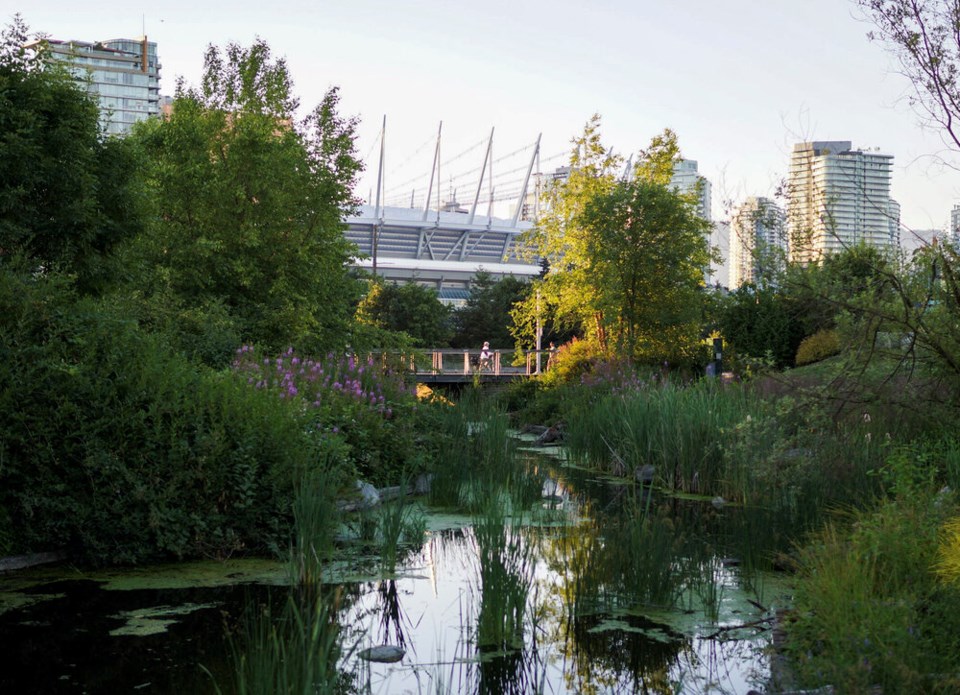Ottawa has invited the City of Vancouver to access $20 million, money flagged to scale up green infrastructure like rain gardens and green roofs, and help the city meet its target of filtering 90 per cent of all rain that falls on the city by 2050.
The ambitious 30-year target is expected to cost hundreds of millions of dollars, and is one of several measures Vancouver has proposed to mitigate and adapt to a warming planet.
If the city were successful in applying for the full $20 million, that would fund several dozen blocks of green infrastructure, according to Jimmy Zammar, the City of Vancouver’s director of urban watersheds, sewers and drainage.
“We’re spending like $20 million in the last four years,” he says. “It is definitely a scaling up on our current investment.”
Zammar says it would allow the city to take on projects at a district scale and build up nature-based infrastructure in underserved areas not currently under development.
GREEN INFRASTRUCTURE FOR RAINSTORMS
Climate change is expected to lead to more extreme rainfall events in the winter across B.C.’s South Coast. A recent 734-page report from Natural Resources Canada warned infrastructure could buckle in communities across the country as extreme weather events, from rainstorms to heat waves, become more intense and more frequent.
Take an extreme rainfall event: Traditional infrastructure sends rainwater as fast as possible to storm drains, into waterways and out to sea. But when too much water falls, the rigid system can lead to backed-up sewers and flooding.
Green infrastructure — often an engineered matrix of native plants, known as bioswales, and soil — absorbs runoff during heavy rainfalls, slowly letting it into the sewer system. In other words, it flattens the flood curve.
That being said, contaminated urban landscapes can lead to polluted rainwater as it washes across streets and into waterways.
In December 2020, a groundbreaking study out of Washington State found particles shed by aging vehicle tires were the long-sought fatal source leading to mass die-offs of adult coho salmon. The culprit? A preservative called 6PPD-quinone, added to prevent damage to tire rubber from ozone. Filter out the preservative with the right kind of plant-soil mixture and many of those deaths could be avoided, say researchers.
GREEN INFRASTRUCTURE DAMPENS HEAT WAVES
It’s not just aquatic ecosystems that reap the immediate benefits of allowing the forest back into the city. The record-breaking heat wave that scorched B.C. two weeks ago has been linked to a rise in at least 579 sudden deaths. While causes of death are still being investigated, most have been reported in the Lower Mainland, where concrete and steel concentrate temperatures in what’s known as an urban heat island.
Zammar says his team had been anticipating such an event after looking at cities like Amsterdam, where risks due to rising seas have been replaced by heat and drought.
“We normally think of the effects of climate change as wildfires or flooding elsewhere in the province. The heat dome really demonstrated those risks are felt by our community directly,” says Zammar. “It really amplifies the urgency.”
Adding trees, plants and soil to the streets and roofs of the city have been shown to mitigate that heating effect. When the water absorbed and held by green infrastructure slowly evaporates, it cools the surrounding air.
That could prove increasingly useful in a future where climate scientists say such devastating heat waves could hit the province every five to 10 years as early as 2040.
“These kinds of solutions create a kind of triple-word score,” says Zammar.
The funds are part of the $200 million set aside in the 2021 federal budget to establish a Natural Infrastructure Fund. The fund is meant to support natural and hybrid infrastructure projects through small- and large-scale projects.
Stefan Labbé is a solutions journalist. That means he covers how people are responding to problems linked to climate change — from housing to energy and everything in between. Have a story idea? Get in touch. Email [email protected].



.png;w=120;h=80;mode=crop)